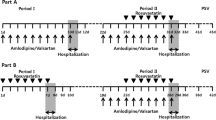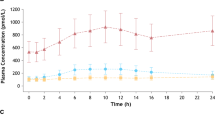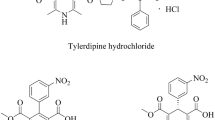Abstract
Colesevelam hydrochloride (colesevelam) is a novel, potent, bile acid–binding agent that has been shown to lower LDL cholesterol a mean of 19% at a dose of 3.8 g/d. We studied the pharmacokinetics of colesevelam coadministered with six drugs: digoxin and warfarin, agents with narrow therapeutic indices; sustained-release verapamil and metoprolol; quinidine, an antiarrhythmic with a narrow therapeutic index; and valproic acid, an antiseizure medication. Six individual studies were single-dose, crossover, with or without a 4.5-g dose of colesevelam. Plasma levels were determined using validated analytical methods. Values for the ratio of ln[AUC(0-t)] with and without colesevelam were 107% for quinidine, 102% for valproic acid, 89% for digoxin, 102% for warfarin, 82% for verapamil, and 112% for metoprolol. Values for the ratio of ln[Cmax] with and without colesevelam were 107% for quinidine, 92% for valproic acid, 96% for digoxin, 99% for warfarin, 69% for verapamil, and 112% for metoprolol. The 90% confidence intervals for these ratios and for values of ln[AUC(0-inf)] that could be determined were within the 80–125% range, with the exception of verapamil. In this study, verapamil had great interindividual variability, with a 28-fold range in Cmax and an 11-fold range in AUC(0-t). In summary, pharmacokinetic studies with colesevelam did not show clinically significant effects on absorption of six other coadministered drugs.
Similar content being viewed by others
References
Expert Panel. Summary of the second report of the National Cholesterol Education Program (NCEP) Expert Panel on detection, evaluation, and treatment of high blood cholesterol in adults (Adult Treatment Panel II). JAMA 1993;269:3015-3023.
Levine GN, Keeney JF, Jr., Vite JA. Cholesterol reduction in cardiovascular disease. N Engl J Med 1995;332:512-521.
Scandinavian Simvastatin Survival Study Group. Randomised trial of cholesterol lowering in 4444 patients with coronary heart disease: The Scandinavian Simvastatin Survival Study (4S). Lancet 1994;344:1383-1389.
Lipid Research Clinic Program. The Lipid Research Clinics Coronary Primary Prevention Trial results. l. Reduction in incidence of coronary heart disease. JAMA 1984;251:351-364.
Knopp RH. Drug treatment of lipid disorders. N Engl J Med 1999;341:498-511.
Avorn J, Monette J, Lacour A, et al. Persistence of use of lipid-lowering medications: A cross-national study. JAMA 1998;279:1458-1462.
Bays HE, Dujovne CA. Drug interactions of lipid-altering drugs. Drug Saf 1998;19:355-371.
Davidson MH, Dillon MA, Gordon B, et al. Colesevelam hydrochloride (Cholestagel): A new, potent bile acid sequestrant associated with a low incidence of gastrointestinal side effects. Arch Intern Med 1999;159:1893-1900.
Wilson TA, Nicolosi RJ, Rogers EJ, Sacchiero R, Goldberg DJ. Studies of cholesterol and bile acid metabolism, and early atherogenesis in hamsters fed GT16-239, a novel bile acid sequestrant (BAS). Atherosclerosis 1998;140:315-324.
Shepherd J. Mechanism of action of bile acid sequenstrants and other lipid-lowering drugs. Cardiology 1989; 76(Suppl. 1):65-71.
Braunlin W, Zhorov E, Smisek D, et al. In vitro comparison of bile acid binding to colesevelam HCl and other bile acid sequestrants. Polymer Preprints 2000;41:708-709.
Brown DD, Juhl RP, Warner SL. Decreased bioavailability of digoxin due to hypocholesterolemic interventions. Circulation 1979;58:164-172.
Jahnchen E, Meinertz T, Gilfrich HJ, Kersting F, Groth U. Enhanced elimination of warfarin during treatment with cholestyramine. Br J Clin Pharmacol 1978;5:437-440.
Malloy MJ, Ravis WR, Pennell AT, Diskin CJ. Effect of cholestyramine resin on single dose valproate pharmacokinetics. Int J Clin Pharmacol Ther 1996;34:208-211.
Gallo DG, Bailey KR, Sheffner AL. The interaction between cholestyramine and drugs. Proc Soc Exp Biol Med 1965;120:60-65.
Neuvonen PJ, Kivisto K, Hirvisalo EL. Effects of resins and activated charcoal on the absorption of digoxin, carbamzepine and frusemide. Br J Clin Pharmacol 1988; 25:229-233.
Brown DD, Juhl RP, Warner SL. Effects of hypocholesterolemic interventions on digoxin bioavailability. Drug Metab Rev 1979;9:107-117.
Robinson DS, Benjamin DM, McCormack JJ. Interaction of warfarin and nonsystemic gastrointestinal drugs. Clin Pharmacol Ther 1971;12:491-495.
Questran Package Insert. Physicians Desk Reference, 1999.
Hunninghake DB, King S, LaCroix K. The effect of cholestyramine and colestipol on the absorption of hydrochlorothiazide. Int J Clin Pharmacol Ther Toxicol 1982;20:151-154.
Young MA, Lettis S, Eastmond R. Concomitant administration of cholestyramine influences the absorption of troglitazone. Br J Clin Pharmacol 1998;45:37-40.
Brown DD, Juhl RP, Warner SL. Decreased bioavailability of digoxin due to hypocholesterolemic interventions. Circulation 1978;58:164-172.
al-Meshal MA, el-Sayed YM, al-Balla SR, Gouda MW. The effect of colestipol and cholestyramine on ibuprofen bioavailability in man. Biopharm Drug Dispos 1994;15:463-471.
Malloy MJ, Ravis WR, Pennell AT, Hagan DR, Betagari S, Doshi DH. Influence of cholestyramine resin administration on single dose sulindac pharmacokinetics. Int J Clin Pharmacol Ther 1994;32:286-289.
Kivisto KT, Neuvonen PJ. The effect of cholestyramine and activated charcoal on glipizide absorption. Br J Clin Pharmacol 1990;30:733-736.
Hibbard DM, Peters JR, Hunninghake DB. Effects of cholestyramine and colestipol on the plasma concentrations of propranolol. Br J Clin Pharmacol 1984;18:337-342.
Friedman H, Greenblatt DJ, LeDuc BW. Impaired absorption of tetracycline by colestipol is not reversed by orange juice. J Clin Pharmacol 1989;29:748-751.
Colestid Package Insert. Physicians Desk Reference, 1999.
Forland SC, Feng Y, Cutler RE. Apparent reduced absorption of gemfibrozil when given with colestipol. J Clin Pharmacol 1990;30:29-32.
Brown DD, Schmid J, Long RA, Hull JH. A steadystate evaluation of the effects of propantheline bromide and cholestyramine on the bioavailability of digoxin when administered as tablets or capsules. J Clin Pharmacol 1985;25:360-364.
Klotz U, Antonin KH. Biliary excretion studies with digoxin in man. Int J Clin Pharmacol Biopharm 1977;15:332-334.
Caldwell JH, Greenberger NJ. Interruption of the enterohepatic circulation of digitoxin by cholestyramine. l. Protection against lethal digitoxin intoxication. J Clin Invest 1971;50:2626-2637.
Henderson RP, Solomon CP. Use of cholestyramine in the treatment of digoxin intoxication. Arch Intern Med 1988;148:745-746.
Author information
Authors and Affiliations
Rights and permissions
About this article
Cite this article
Donovan, J.M., Stypinski, D., Stiles, M.R. et al. Drug Interactions with Colesevelam Hydrochloride, a Novel, Potent Lipid-Lowering Agent. Cardiovasc Drugs Ther 14, 681–690 (2000). https://doi.org/10.1023/A:1007831418308
Issue Date:
DOI: https://doi.org/10.1023/A:1007831418308




